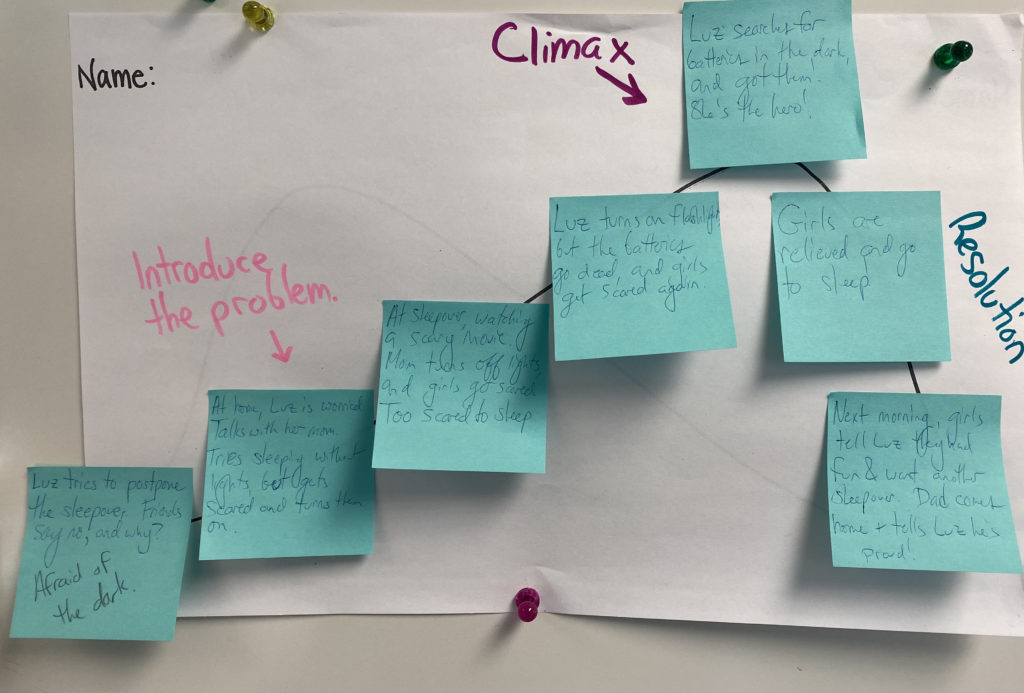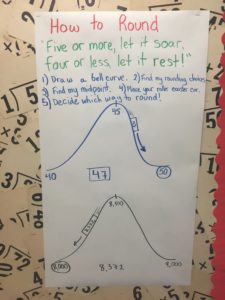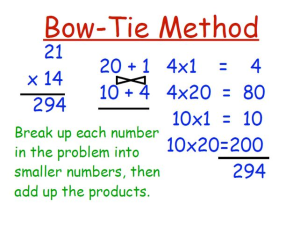Viewing: place value
October 14, 2022
Crafting Narrative Stories, Learning about Place Value
October has been a busy month in Room 209! Today, we wrapped up our first math unit, and students worked very hard on their math assessment. (I don’t return graded assessments until all students complete the test, so you won’t see them coming home for at least another week, as we have students who were absent today and who didn’t get to begin the assessment. We have been learning about place value, addition, and subtraction (as you’ve seen on homework).
Next week, we will kick off our second unit, which focuses on factors and multiples. You can best support your student by helping him or her to practice multiplication facts. My math department colleagues over at Avon Middle School and Avon High School continue to tell me that math fact mastery is the SINGLE MOST IMPORTANT skill kids need in order to be prepared for upper grades, and it’s SO critical that they practice at home. While this was a focus of in-class time in third grade, in fourth grade, the expectation is that kids practice at home (if the skills aren’t yet mastered).
Over the past few weeks, we’ve started having math groups, which will ensure that all students receive the support and small-group instruction that’s right for them. These will continue to phase in over the next few weeks. Many students have worked in small groups with me already, but this will grow in coming weeks.
In reading, we are learning all about characters. This week, we have been focusing on developing higher-level thoughts about characters, in turn, how to interpret complicated characters. As kids mature as readers, the books they read tend to evolve from having characters that are all-good or wholly-evil (Think: Cinderella vs. her step-mother) and instead have flawed protagonists who are imperfect but still the hero of the story, and complicated antagonists who may be “the bad guy” in the story, while still having some redeeming qualities. Students are also working on developing detailed written responses about these characters, which will be a bigger focus next week.
In writing, students are working on drafting their narrative pieces. We’re learning how and when to add storytelling details to better develop a key part, and when to fast-forward (summarize) a part that’s less important. Students need to finish their drafts next week so that we can begin to revise. This will be a homework assignment next week for students who aren’t yet finished with their drafts. I asked all students to bring home their writing and their story arcs (see photo) today because I know week nights can be busy for families, and I wanted to give you/them the OPTION to continue working this weekend if that is preferable for your family’s schedule. Please understand that it is certainly not required to work on this over the weekend; I just wanted to give the option to students (and they know it’s really up to their families to decide how to best schedule in the work time). I do ask that if your student works on his/her writing at home, please resist the urge to work with him/her to put your grown-up finesse on the draft. We’re working together in class, and I enjoy getting to conference with many, many students each week, so everyone will get one-on-one time to work with me. I’d ask that you allow me to be the one to work with your kids on THIS piece, and that you take on the role of being your fourth grader’s best cheerleader and supporter, because your kids’ writing DEFINITELY is worthy of cheer! They are doing great work!
Science will be starting up soon, so you can expect to hear more from your kids! Lastly, in the middle of dismissal today, a kind student reminded me that I had a pile of school photos that I hadn’t yet passed out to students. Many students brought them home today, but if your child didn’t, don’t worry! They’re in your student’s mailbox to be brought home on Monday. I apologize for the delay! Your kids’ photos are terrific! 🙂
Posted in Class Updates|By Jon Moss
November 4, 2018
Methodical Math Mania!
In room 209, we have been working hard on a variety of different math skills. In our current unit, which we’ll be assessing this week, students have learned about factors, multiples, the order of operations, patterns, problem solving, and more. I hope that the videos I’ve posted are helpful to you, both in keeping you up to date on what skills we’re covering and in better equipping you to support your fourth grader. Students have been working very hard in math.
Our first math unit focused on place value, addition, and subtraction. You may be wondering about the unit 1 assessment scores. When I review student assessment results, I look to see what strengths emerged and which areas were challenging for students. When I see that a few students have struggled with a particular area, I pull groups to review the difficult skills. When the number of students struggling with a skill is larger, it shows me that I need to do some reteaching for the whole class. On the unit 1 assessment, I saw that the majority of students continued to need practice with rounding and with a few other place value skills. Over the past few weeks, I’ve been reviewing various skills with small and large groups of students, and we’re going to continue this work to ensure that students have a solid foundation for our upcoming units. So while these assessments haven’t gone home yet, I look forward to reviewing them with you in person at our upcoming parent conference so we can discuss your fourth grader’s progress.
We’re also working on improving students’ addition and subtraction facts. Students are making progress in these skills, but this may also be a good focus for home practice. This may come as a surprise for you, as the big focus in third grade was multiplication. Fear not, we’ll soon return to multiplication facts as we dive into the multiplication units of study. But I often find that students’ addition and subtraction fact mastery tends to slip when they shift their focus to multiplication. So by taking the first marking period to work on addition and subtraction facts, I’m again hoping that students will have a solid basis for the skills in the upcoming units of study.
Posted in Class Updates|By Jon Moss
October 23, 2017
Let’s add up what we’ve learned in math!
Our first math unit focused on place value, addition, and subtraction. Throughout the unit, you may have noticed several tutorial videos that I posted on our class website. I make these as a way of extending my instruction to the home setting, and to also help you to best help your fourth grader. I’ve been posting these on our class website, but starting now, I’ll instead post them in our Google Classroom account. This makes it easier for students to access them, and it allows me to catalog them by subject.
Today, students are bringing home their first math assessment. I have a practice of not returning corrected assessments until all the students have completed them, and that only recently happened. I found a wide range of student performance on the assessment. Let me tell you a bit more:
- Question 21 was challenging for many students. If you find your student’s grade was lower than you would like, take a look to see that problem. It was worth 6 points, and since the whole test was worth 35 points, it had a big effect on students’ overall grades. We’re going to review that problem type in depth on Thursday this week.
- In Targeted Instruction, students work on skills that are right for them. Based on their performance on the math assessment, many students are reviewing place value skills in general or rounding skills in specific during the TI block. So while you’re just now receiving these assessments, please know that students in either of these groups are entering their second week of focused, small group practice with these skills. Your child can tell you if he or she is in one of these groups.
- We’ll continue to improve students’ understanding of place value throughout the year as we progress through other units.
If you have any questions, please feel free to email me. We’re wrapping up the second math unit this week, and I expect to be giving the unit 2 assessment either on Friday or early next week.
Posted in Class Updates|By Jon Moss
September 14, 2016
Day 9: What’s happening?
It feels as if we’ve been in school for many weeks! The students are doing a great job learning the routines of our class, and this has allowed us to move into our curriculum with efficiency and enthusiasm! Our first focus in reading has been discussing many of the strategies that successful readers use. We’ve discussed how readers choose books for themselves, why some readers abandon books, and how to use our class library. This afternoon, we’re going to again team up with Ms. Kelleher, our library-media specialist, to learn about how to choose a “Just Right” book for ourselves. This will be helpful as we find students’ independent reading levels in the coming weeks. Yesterday, we learned about how to “buzz”, that is, how to have a group conversation about a single topic. You might be surprised to hear that we’re focusing on something so fundamental, but we’ve found in fourth grade that dedicating time NOW to discussing the basic ideas of taking turns, making eye contact, etc. allows student discourse down the road to be significantly more productive and engaging.
In math, we’ve been working on place value! Our first few lessons introduced place value concepts and built upon the students’ prior skills. Today, we worked on rounding numbers; a concept that we’ll spread out over a few days. Estimation can be a challenging skill for students, so I teach them the roller coaster strategy. (See picture.) This method lets students break up the rounding process into five steps, and by adding a visual piece, it makes it less overwhelming for many learners. Feel free to show this image to your fourth grader to help them with their homework. Tomorrow, we’ll translate this strategy to a more traditional process in which they round numbers without the elaborate visual process. We’ll return to the roller coaster method when we work on rounding to different places, such as taking a number like 8,372 and rounding to the nearest thousand (8,000) or nearest hundred (8,400) or nearest ten (8,370). I don’t expect mastery on day one, and I admire the hard work students are showing!
We’ve started our Targeted Instruction rotations! As I explained at curriculum night, TI will allow us to meet each student’s individual needs by breaking up classes. For example, during the TI block one week, I might focus on rounding numbers, Mrs. Castle might focus on descriptive writing, and Miss Lacasse might focus on map skills. Rather than whole classes traveling together, we’ll each send our students to the teacher who is offering the activity that best fits student needs. We’re excited to have many different teachers collaborating with us, so stay tuned! This week, students ARE rotating among each teacher as whole classes in order to establish routines. Next week, we’re going to start to shuffle students.
Questions? Send me an email! Have a great day!
Posted in Class Updates|By Jon Moss
November 24, 2015
Unit 3 Math – Multiplication Strategies
Hello everyone,
Over the past few weeks we have been working on several different strategies for multiplying, specifically multiplying 2-digit by 2-digit numbers. We will be finishing this unit today (November 24th), and we will review after Thanksgiving weekend, before their assessment. To help with this review, Mr. Moss and I thought it would be helpful to post some videos of the different strategies.
The first lesson was to estimate numbers before multiplying them so that you can just multiply the basic math fact and then add the zeros at the end. Here is a video to help explain that a bit better:
The next day, we worked on using the area model to actually do 2-digit by 2-digit multiplication. Think of taking a rectangle are breaking it apart into parts, finding the area of each rectangle and then adding it all back together. Here’s another video for that method:
After that, we worked on using partial products to multiply. Basically, doing the same thing as the area model, but without the box. Here’s a picture to help:
And, of course, another video to help:
Finally, we got to the standard method of multiplication. We started by looking into why this method works, something even most adults are unsure of. We broke apart the multiplication problem again, but instead of breaking into four parts like with the partial products method, we broke it into two. Students know how to do 2-digit by 1-digit multiplication well by now. They also know how to multiply 2-digits by 2-digits as long as one of the numbers ends in a zero. So we took apart the bottom number, for example:
23 became 23 and 23
x 34 x 30 x 4
Students can much more easily do 23 x 30 and 23 x 4 than they can do 23 x 34.
Once they found the answer to both parts of the broken up problem. We added them together.
Finally, we learned how to do it all together – the same way we all learned – with regrouping numbers. Here’s a video to better explain that (2-digit by 2-digit with regrouping starts at 3:20)
We want students to be familiar with all 3 methods of multiplication, but they can use whichever method they like best when doing multiplication from here on out. Today, we discussed how everyone has different preferences when it comes to math and that it’s ok for them to pick their favorite method when doing multiplication.
Hopefully this wasn’t too confusing for everyone; it’s harder to explain in writing than it is in person. But the videos should do a pretty good job of giving a visual to my rambling.
Enjoy!
~ Mr. Walmer
Posted in Class Updates|By Brendan Walmer
October 17, 2014
Dividing Tens, Hundreds, and Thousands
OC 38
CC.4.NBT.6
Posted in Learning Resources, Math, Unit 1|By Jon Moss
September 9, 2014
Tuesday’s morning work
Good morning! As you come in, I’d like to you get a partner and take an iPad. (One iPad PER partnership, please.) Below this paragraph, you will find a link to a video I made about comparing numbers. Please tap that link and watch the video. Make sure it’s loud enough for you to hear, but don’t make it so loud that it distracts other groups. And go!
https://www.educreations.com/lesson/view/comparing-numbers/10712834/
Posted in Class Updates|By Jon Moss
September 4, 2014
Many Names for Numbers (when using Place Value)
OC Lesson 16
CC.4.NBT.1
Posted in Learning Resources, Math, Unit 1|By Jon Moss



